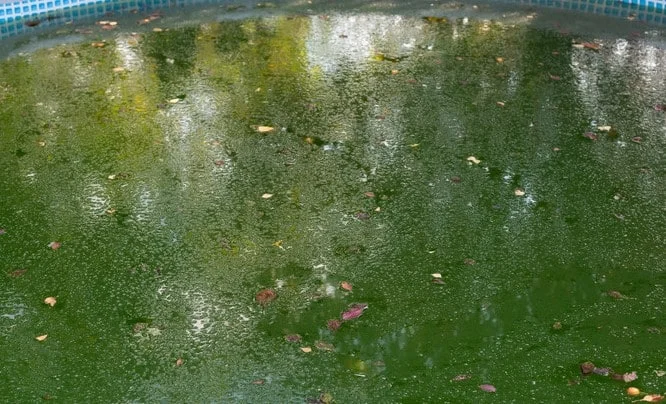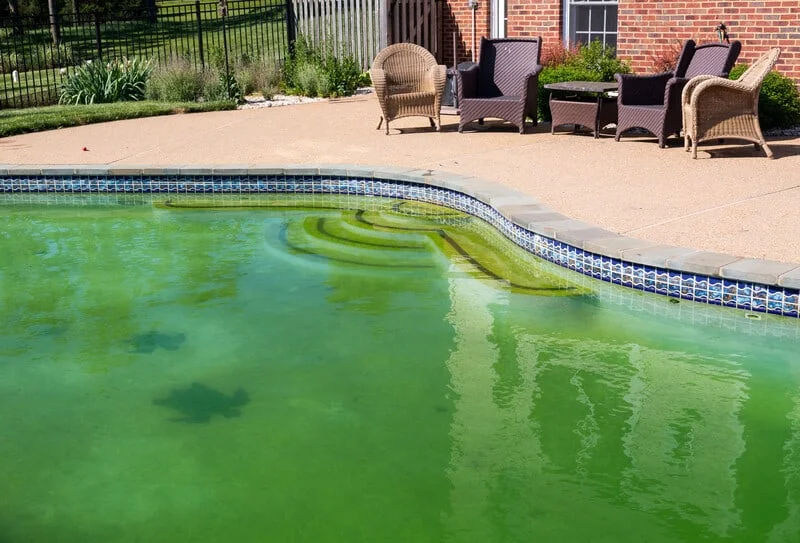Got Hot Tub Algae? Spa Algaecide is Only a Small Part of the Solution
Nothing zaps a relaxing evening like going out to kick back in your hot tub and finding the water is murky and dark with splotches defacing the walls of your tub. Hot tub algae is an unsightly issue that’s a common nuisance among spa owners. Thankfully, there are many ways to remove several types of hot tub algae that exist. Also, preventative care will reduce algae outbreaks in the future. By following expert advice, you can maintain your hot tub’s health, avoid contracting skin rashes, and eliminate the hassle of fighting an algae infestation.

Problems caused by algae
Hot tub algae invite bacteria to settle into the spa’s water and walls, spurring issues to arise such as discolored, unsanitary water and skin irritations. For example, hot tub folliculitis, or hot tub rash, is an uncomfortable but relatively common side effect of a poorly maintained spa. The rash is distinguishable with painful or itchy red bumps that can appear anywhere on the body within 1 to 4 days of being in a contaminated hot tub.
Unsanitary water conditions due to low alkalinity and pH imbalance allow agitating species of spa algae to birth and harmful bacteria to congregate.
Causes of algae
Leaving your hot tub uncovered exposes it to sunlight and the weather. Organic materials that land in the spa water are subject to deterioration, creating a hotspot for green algae in your hot tub to bloom. Spa water evaporates faster when left uncovered and causes a quicker imbalance of chemicals in the spa.
Another cause is dirty hot tub filters, decreasing the filters’ effectiveness, leading to contaminants’ buildup. A dirty filter discolors and impurifies the water. Without proper circulation to collect foreign particles, the water will stagnate, forming harmful bacteria. Hot tub algae thrive in these environments.
A third contributor to algae is low alkalinity and pH, making it difficult for the sanitizer to be effective. This results in highly acidic water. Fluctuations of alkalinity and pH continuously lead to a chemical imbalance leaving your hot tub exposed to collecting harmful bacteria and harboring hot tub algae.

How to remove algae & use spa algaecide
Once algae have begun growing in your hot tub, you’ll want to start fresh. Removing spa algae requires consistent effort to reduce the chance of a reoccurring invasion. Different types of hot tub algae and mold may require other chemical solutions, like hot tub algaecide. So typically, you’ll want to begin with fresh water and follow these necessary steps to remove algae from your hot tub.
First:
1. Scrub the algae and mold off the tub and vacuum debris.
2. Empty the water from your tub.
3. Clean and sanitize the filter.
4. Refill with a hose filter and heat to the preferred temperature.
Next:
5. Adjust the pH and alkalinity to balance the water.
6. Shock the water.
7. Treat with spa algaecide in super-resistant algae instances.
Finally:
1. Maintain water hardness, pH balance, and Total Alkalinity by checking the levels daily.
2. Create a hot tub maintenance plan (see our guide on hot tub water maintenance).
Hot tub algae prevention
Ensuring proper filtration of the water in your hot tub is vital to your spa’s overall health, including preventing algae. To reduce chemicals and improve your hot tub water’s integrity, schedule your water to filter 8 hours a day, and if your spa uses a low-volume circ pump/hush pump, it should be programmed to filter 24/7.
A thoroughly cleaned filter also plays a significant role in the filtration and sanitization of the water. Without a functioning filter, debris will build up, and algae can make its presence or reoccur. To meticulously clean the filter, soak it in a product like Spa Marvel Filter Cleaner and then give it a high-pressurized, gentle rinse. If the cleaning doesn’t remove deep stains, like ones caused by black algae in your hot tub, you may need a replacement filter.
Also, maintain pH balance and alkalinity daily to increase your waters’ quality and reduce the amount of chemicals needed for correction. The ideal parts per million (ppm) should be between:
pH: 7.2 – 7.8 ppm
Alkalinity: 80 – 150 ppm
Hardness: 175 – 250 ppm
Utilizing these hot tub algae prevention methods will keep your hot tub ready for use year-round. Now, you can relax, knowing the health of your spa is of high integrity. Your water will be balanced and rely on minimal chemicals.

Types of hot tub algae
Several spa algae and molds can plague any neglected spa. Algae and mold thrive in warm, wet environments and grow in temperatures over 68 degrees Fahrenheit. Once an algae infestation has occurred, it can be troublesome to eradicate without acting quickly. Using spa algaecide once weekly will reduce the spawning of hot tub algae.
Green algae in a hot tub are the most familiar to spa owners, associated with the deep green tint it gives the water. It’s found everywhere there is water. You’ll find green algae in your hot tub on the walls or floating on top of the water.
Yellow algae in the hot tub, or mustard algae, is easy to scrub off but difficult to eliminate permanently. Yellow algae in the hot tub have chlorine resistant properties and defend itself against sanitizers. Use a spa algaecide to enhance the effects of fighting yellow algae in the hot tub after the initial high chlorine shock treatment.
Black algae in the hot tub are difficult to scrub off and challenging to knock out permanently. Black algae in the hot tub are found in the spa’s crevices and cracks, clustering where you may least expect. Algae form roots deep into the surface they inhabit, commonly causing permanent stains on the walls of your spa and water filter. Black algae in the hot tub are found in the spa’s crevices and cracks; clustering where you may least expect. Use hot tub algaecide when treating for black algae in your hot tub.
White algae in the hot tub, or white mold, is an airborne fungus that resembles flakes with a fuzzy like texture. White mold, often assumed to be white algae in a hot tub, can clog your pump in extreme cases. High alkalinity and faulty filtration are the common culprits for white mold.
A consistent balance of chemicals, hot tub algaecide, and sanitizers will prevent hot tub algae outbreaks in the future. Proper filtration will keep the water circulating, and a clean filter will pick up harmful particles. Both of these prevent a buildup of toxic bacteria. To keep your spa maintained and prevent hot tub algae, use high-quality products and expert advice so you can enjoy a clean and relaxing experience.









